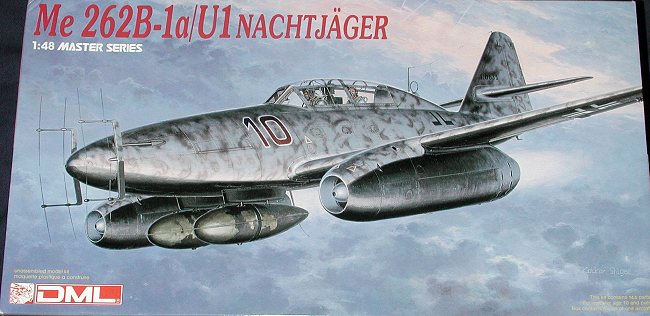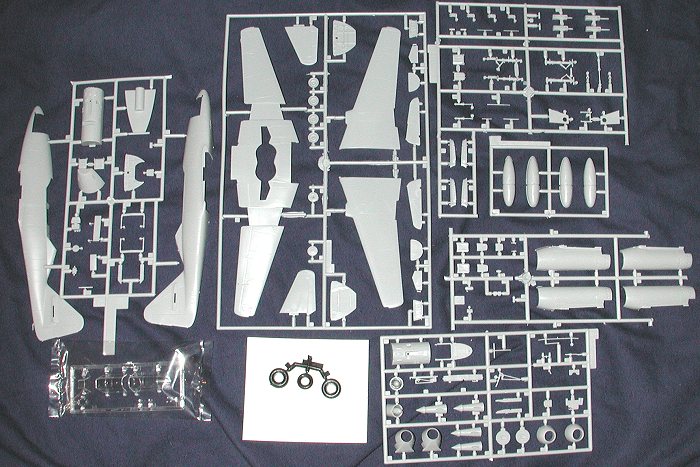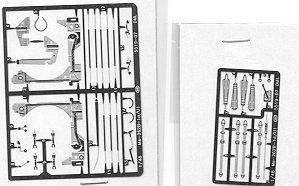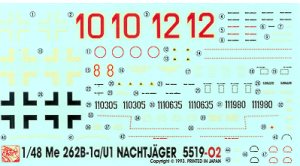
|
KIT: |
DML 1/48 Me-262B-1a/U2 |
|
KIT # |
5519 |
|
PRICE: |
$ |
|
DECALS: |
Two aircraft |
|
REVIEW & |
|
|
NOTES: |
Master Series |

|
HISTORY |
Most of you reading this have some idea of the history and development of the Me-262. The aircraft has always elicited a picture of hordes of 262s armed with R4M rockets speeding into a bomber stream and destroying a vast multitude of Allied bombers. As always, reality is much more mundane and while the aircraft did promote a lot of concern, its implementation was not as widespread or devastating as was originally supposed.
So different and radical were turbine engines, that Messerschmitt built a dedicated trainer version, the Me-262B. Before this, the prospective pilot was given about 8 hours of ground training on knobs and switches as well as some taxiing experience with a qualified pilot hanging on to the outside of the cockpit as the trainee went careening around the taxi ways. Not exactly my idea of fun and games. The development of the 262B meant that more meaningful training could be done. However, there was a price to pay.
In order to accommodate the additional seat, the aft fuselage fuel tank had to be removed. This meant less fuel, not a good thing for the thirsty turbojets. To make up for that, drop tanks were installed under the nose where the bombs would go on the fighter bomber version. The nose armament was also reduced to just two Mk108 30mm cannon instead of the usual four.
Having this really neat two seater available encouraged the Luftwaffe to adapt it as a night fighter. Now they had a relatively small two seat jet that was big enough to carry an airborne radar set and its operator. Though a dedicated Me-262 night fighter was under development as the war ended, a number of trainers were modified as interim night fighters. For the most part, all of these operated with 10./NJG 11 in defense of Berlin. How successful they were is not known. Several were captured at the end of the war and at least one of them is on display in South Africa.
|
THE KIT |

As most of you know, DML basically took the Trimaster molds and recast the metal landing gear and wheels in plastic, leaving the etched frets as they were. This not only brought down the price, but eliminated, what to me, is an unnecessary addition to the kit. Metal gear should be limited to those kits that need the extra strength. What was not redone were the rubber tires and you get those in this kit. They don't seem to be the plastic-eating variety as mine were loose in with sprues of plastic with no ill effects.
 In addition to the rubber tires, there are also two
frets of etched steel. One is for seat belts and the other contains items like
the radar antenna, df loop, and wheel well inserts to name a few. The rest of
the kit is very much what one has come to expect from DML. The engraved plastic
is a bit harder than most, which is fine. Details are very well done and there
is no flash on any of the pieces. Ejector pin marks are kept to a minimum and
are mostly hidden from view on the finished model.
In addition to the rubber tires, there are also two
frets of etched steel. One is for seat belts and the other contains items like
the radar antenna, df loop, and wheel well inserts to name a few. The rest of
the kit is very much what one has come to expect from DML. The engraved plastic
is a bit harder than most, which is fine. Details are very well done and there
is no flash on any of the pieces. Ejector pin marks are kept to a minimum and
are mostly hidden from view on the finished model.
There are not very many options on this kit, but one is a separate rudder. However, you'll have to cut away the one already on the kit in order to install it. I doubt if many will go for that option! You can also leave the gun bays open as well as the canopies should you desire. By leaving off all the night fighting stuff, one could easily make a standard trainer from this kit. The only thing needed would be a more normal instrument panel for the back seater.
 The instruction sheet is up to current
standards offering logical construction steps as well as having painting
information in all the steps. Paints are referenced to Gunze Sangyo colors as is
the norm with nearly all kits made in the Orient. There is also an Italeri paint
reference, but no indication of RLM numbers, which would have been more helpful.
There are two aircraft camouflage options, both of which are similar. They
appear to be dark grey uppers with RLM 76 squiggles all over th upper surfaces
for Red 10 and a lighter grey squiggles on the fuselage only for Red 12.
Undersides of both aircraft are black. Decals appear to be relatively thick, but
should work quite well as long as very warm to hot water is used.
The instruction sheet is up to current
standards offering logical construction steps as well as having painting
information in all the steps. Paints are referenced to Gunze Sangyo colors as is
the norm with nearly all kits made in the Orient. There is also an Italeri paint
reference, but no indication of RLM numbers, which would have been more helpful.
There are two aircraft camouflage options, both of which are similar. They
appear to be dark grey uppers with RLM 76 squiggles all over th upper surfaces
for Red 10 and a lighter grey squiggles on the fuselage only for Red 12.
Undersides of both aircraft are black. Decals appear to be relatively thick, but
should work quite well as long as very warm to hot water is used.
Dragon 262 kits have a rather checkered history of looking great but needing work to construct. This one is probably no different, however, careful construction should yield a superior model.
Review kit courtesy of me and my wallet!
If you would like your product reviewed fairly and quickly by a site that has over 1,700 visits a day, please contact me or see other details in the Note to Contributors.